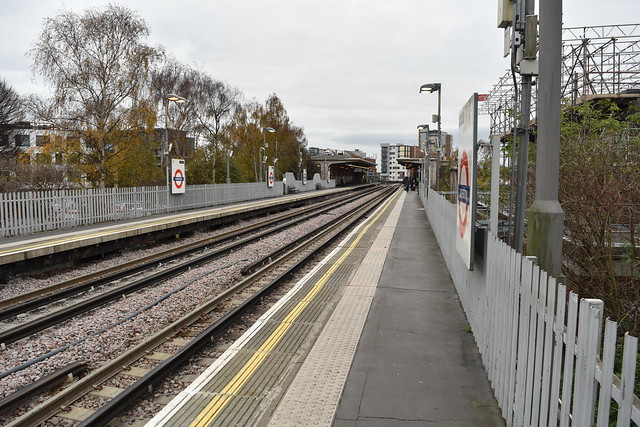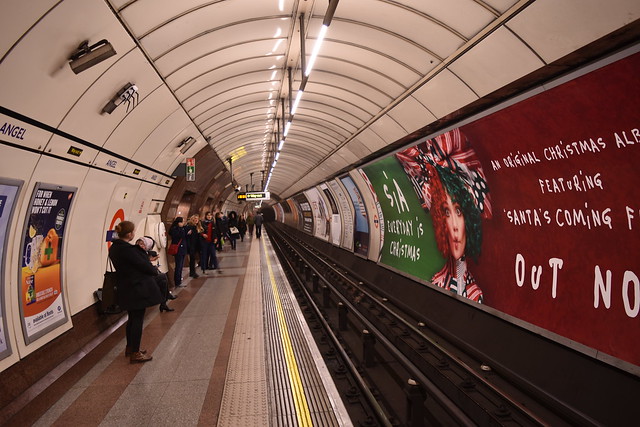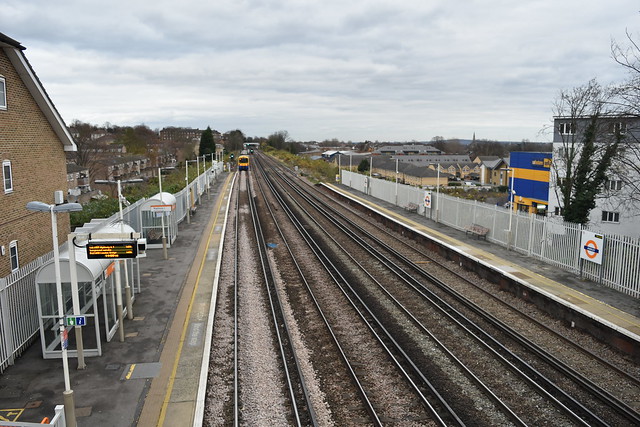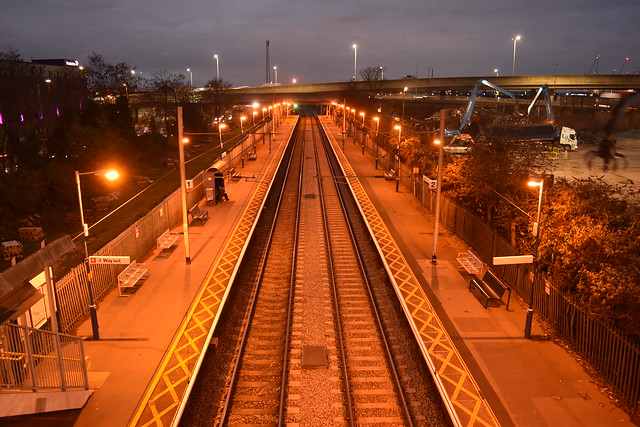I'm undertaking a project to visit all 598 Underground, Overground,
National Rail, DLR, Tram and Cable Car stations in Greater London in
alphabetical order. Here's Day 3.
It's a cold morning on the 6th December 2017, and I'm out and on a train to Wimbledon, where I change for the District line to Earl's Court. One more change takes me to the subterranean Piccadilly line platforms, and I'm soon on the way to...
Alperton (ALP)
Station opened: 28th June 1903 (as Perivale Alperton)
Railway opened: 28th June 1903 (by the District Railway)
Served by: London Underground Piccadilly line
Zone: 4
Passenger entries/exits (2017): 3.05 million
Stations served:
- Cockfosters (6pth)
- Rayners Lane (3tph)
- Uxbridge (3tph)
Alperton lies on the Piccadilly line, on the northbound branch from Acton Town towards Rayners Lane and Uxbridge. Originally opened by the District Railway (as the first electrified surface line on the Underground network), the station transferred to the present-day Piccadilly line in 1932. In preparation for this, the original timber framed structure was demolished, and in its place was built a Charles Holden-designed brick construction, topped with a flat roof (the design was repeated all along the Piccadilly line; some are now Grade listed). Inspired by European Modernist archictecture of the time, the design was groundbreaking, although Holden described them as merely "brick boxes with lids". The platforms have concrete canopies at the southern end, supported by concrete pillars; this does make the platforms look a bit bleak and grey, particularly on this overcast morning. Outside the station, one's eye is immediately caught by the intriguingly named Clay Oven Banqueting Suites; the building also houses a cash & carry and a gym. The railway bridge dominates to the right, just past which lies Alperton Bus Garage.

Leaving Alperton behind, I take the Piccadilly back down to Earl's Court, where I change for a District line train to Victoria. From here it's a Southern service to East Croydon, then a tram westwards to...
Ampere Way (AMP)
Station opened: 30th May 2000
Railway opened: 22nd October 1855 (by the Wimbledon & Croydon Railway, on the trackbed of the Surrey Iron Railway)
Served by: Tramlink
Zone: Tram
Passenger entries/exits (2016): 0.615 million
Stations served:
- Beckenham Junction (6tph)
- Elmers End (6tph)
- Wimbledon (12tph)
Ampere Way is situated on the Wimbledon branch of the Tramlink network. Opened in 2000 along with the rest of the tram network, the route had been part of the West Croydon to Wimbledon railway; dwindling passenger numbers saw the line closed in 1997 in preparation for conversion to the current use. The station itself is a standard Tramlink station, with two low platforms, a shelter on each and some Oyster readers.
(A slight aside here: most tram stops look pretty much the same if we're honest, so subsequent entries regarding them may well be shorter and/or refer back to previous entries!)
Ampere Way serves a range of shops in cavernous warehouse-esque settings, probably the most well-known of which is IKEA. Built on the site of the Croydon B power station, the iconic chimneys have become a notable landmark.

I decide against visiting IKEA for a meatball-based lunch, and instead catch a tram to West Croydon, where I change for an Overground train to...
Anerley (ANZ)
Station opened: 5th June 1839 (as Anerley Bridge)
Railway opened: 5th June 1839 (by the London & Croydon Railway)
Served by: London Overground and Southern
Zone: 4
Passenger entries/exits (2016/17): 0.973 million
Stations served:
- Coulsdon Town (2tph)
- Highbury & Islington (4tph)
- London Bridge (2tph)
- West Croydon (4tph)
Anerley is located on what is now the East London Line of the London Overground, between New Cross Gate and West Croydon. Opened in 1839, the name is reputed to come from a local landowner on whose land the station was built; asked what landmark the station should be named for, he is said to have replied, "Mine is the annerley hoose.". The station has a layout typical of others on this section; two platforms (linked by a footbridge) on the outside of 4 tracks, the 2 middle lines being fast lines. In past times there was a grand station building on platform 1, but nowadays a small brick structure suffices, replete with ticket office and waiting room. The station has entrances on both sides; from platform 1, one will find a row of sloped terraced housing on Ridsdale Road, while the other side brings you out to the literally named Anerley Station Road. Here lies a large Wickes, and the station bus stop, under whose shelter a lone person waits for the 249 or 432.
I head back over the footbridge to platform 1 and catch an Overground service to Canada Water, where I change for a Jubilee line train to London Bridge, changing again for a Northern line service to...
Angel (AGL)
Station opened:17th November 1901
Railway opened: 17th November 1901 (by the City & South London Railway)
Served by: London Underground Northern line
Zone: 1
Passenger entries/exits (2016/17): 19.2 million
Stations served:
- Edgware (9tph)
- High Barnet (9tph)
- Morden (18tph)
Angel can be found on the Bank branch of the Northern line. Opened in 1901, it was originally the northern terminus of the City and South London Railway's line from Clapham Common via London Bridge and Bank. An extension to Euston was opened in 1907, and the tunnels were enlarged in the early 1920s. In the 1990s the station was rebuilt, as its cramped central platform was unsuitable for the amount of people using the station. A new tunnel was bored for the northbound line, and the southbound platform was rebuilt to to the size of the original northbound tunnel, taking it from one of the narrowest platforms on the network to one of the widest.
As well as a wide platform, Angel is also home to the longest escalators on the London Underground network, at 60m long. They are one of two sets in the station; the distance from the rebuilt entrance to the platforms required two pairs to transport passengers from surface to train. Ascending the escalators brings me out into a low ticket hall, replete with florist. Stepping outside, I'm met with 3 stalls; Subterranean Flowers, Angel Fruit Cabin and Tout de Suite (providing the slightly strange combination of coffee and dry cleaning) cater for the steady tide of pedestrains hurrying past, although not many seem to stop. A multitude of vehicles rumble past on the main road; some may be making a very long journey, for this is the fledgling A1, stretching all the way to Edinburgh.

I leave the flowers and the A1 behind, and head back down the longest escalator to the wide southbound platform. From here I take the Northern line to Moorgate, change for a Circle line train to Liverpool Street (very lazy I know), before taking a Greater Anglia service to Tottenham Hale. Here I wait for a bus to my next station, a bus that takes so long to arrive that I'm unable to board when it does turn up due to the sheer amount of other people also wanting it. By this point I've been at Tottenham Hale for so long that the reason for catching a bus is now moot, as there's a train to where I want to go. I head back to the train station, and catch another Greater Anglia service to...
Angel Road (AGR)
Station opened: 15th September 1840 (as Edmonton)
Railway opened: 15th September 1840 (by the Northern and Eastern Railway)
Served by: Greater Anglia
Zone: 4
Passenger entries/exits (2016/17): 0.034 million
Stations served:
- Bishop's Stortford (8 trains a day)
- Hertford East (3tpd)
- Liverpool Street (1tpd)
- Stratford (10tpd)
Angel Road is a railway station on the Lea Valley Lines out of Liverpool Street/Stratford, lying between Northumberland Park and Ponders End. As you may have gathered from the frequencies noted in the stations served, Angel Road is not the busiest station in the world; in fact far from it. According to the ORR's 2016/17 station usage figures, Angel Road is the least used National Rail station in London, and honestly, it's not hard to see why. One has to wonder whether the low usage begets the low frequency of service or vice versa, but nevertheless the crux of the matter is that Angel Road just isn't really near anything that would justify large amounts of people using it. The surrounding area is comprised mostly of light industry; a large Tesco is 5 minutes walk down the road, as is IKEA Tottenham (Angel Road is in fact the closest station to the IKEA; I shouldn't think many people go there instead of Northumberland Road!). For nearby residents the Overground line between Liverpool Street and Enfield/Cheshunt provides a much better service, particularly given the fact that Angel Road is only served during peak hours; there are no trains at the station between 09:52 and 16:52, and after 19:52, and no trains at all on weekends or bank holidays. Even when the station was opened it was over half a mile away from the then village of Edmonton; not exactly a convenient transport option.
The station itself is bookended by two roaring flyovers, the northerly one of which provides the sole point of access to the station, down a twisting flight of stairs and along a narrow footpath to the non-London bound platform. The platforms are linked by a footbridge, and the London-bound platform even has a shelter (surprisingly sheltering someone while I was there). Unsurprisingly there is no ticket machine, only an ancient looking PERTIS machine by the entrance, where you can also find a old CRT display providing train service info; info that may soon be obsolete. 600m down the line a new station, called Meridian Water, is opening to better serve a new housing development, and the Department for Transport has begun a consultation on closing Angel Road for good; I can't imagine an enormous amount of people will be protesting the decision.
I walk up the footpath and climb the stairs to emerge on the flyover, serenaded by the noise of traffic and the scrap metal works next door. There's no other word for it; on this dark, cold December evening Angel Road is bleak. Looking around it's hard to imagine how this lonely station could ever have been popular, serving nothing or no-one of any great note. I leave the station behind and head on down to the Tesco, from where incredibly there is a direct bus to Waterloo. Yes, of course I took it all the way there...

